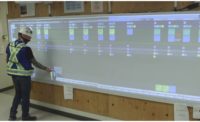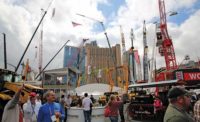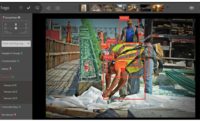Harsh lessons and encouraging signs after a rough year were the top line at the 2021 BuildTech virtual conference, ENR’s annual look at the state of construction technology and management. Contractors, engineers and other industry professionals offered their insights on how they kept working through a pandemic, and the new solutions they uncovered to age-old problems during a difficult time.
ENR special correspondent Tom Sawyer, who was drafted to help develop the first ENR BuildTech conference in 2019, says the planners this year studied feedback from readers and the attendees of ENR events and realized that people really wanted to meet across disciplines and share practical tips for finding synergy among different professions. But the challenges of working through the pandemic were an underlying current throughout the conference.
“Of course the COVID-19 pandemic and last year’s abrupt construction shutdowns and distancing turned up the burners on all of those issues,” Sawyer says. “We always hoped the pandemic would be in the rear-view mirror by the conference start, but it turned out not to be a mirror, but a lens, focusing many of the issues to a hot, bright point.” It wasn’t a “COVID conference,” he says, “but that sure kept coming up.”
Presenters who took to the virtual stage March 9-11 represented companies across the spectrum of infrastructure production, from a team of C-level executives from Skanska USA Buildings, to Norfolk Neb.-based, 45-employee Beckenhaur Construction, all delivering accounts of how their companies coped, adapted and even flourished through the pandemic.
Often, as exemplified by presentations from keynoter Katie Haydon Perry, of Phoenix-based Haydon Building Corp., the key to success turned out to be in a sharper focus on the people side of the equation, and not only the protection of employee health, but in a larger sense, employee well-being. “We did not have a work-from-home policy, we did not have virtual platforms set up,” recalled Haydon Perry, whose company had to move fast as the pandemic spread. “Soon I had a new [virtual] team, and felt we were able to get to know each other on a different level.”
Embracing new communication tools to keep working in a time of crisis came up in a keynote by management consultant Fred Hencke, senior vice president at Segal. He said that working through uncertain times creates a space for misinformation and confusion, and companies have an obligation to keep their own people well informed. “Prepare targeted messages…know which audiences you are trying to reach and communicate effectively,” recommended Hencke. “And when things are really critical, push those alerts out, don’t wait.”
But advances in crisis management soon gave way to exciting new technologies. Matthew Carli, head of material operations at ICON and a former executive at Laticrete, explained how, in partnership the U.S. Marine Corps and the Defense Innovation Unit, ICON 3D-printed a large vehicle-hide structure at Camp Pendleton without a foundation. Using additive manufacturing to deliver concrete structures and forms, Carli explained, extends to the home building industries and even to space exploration where NASA sponsored a competition to create structures on the surface of the moon for future manned lunar projects.
Carli stressed that the acceleration of 3D printing in construction is already underway with more start-ups, corporate investment and government-support 3D concrete printing (3DCP) and that the scale of adoption is already disrupting traditional construction in places such as Singapore. What was seen as a curious lab experiment only a few years ago is now entering the market as a viable alternative to other building methods. “It’s a highly engineered mortar, really over-engineered for this application,” he explained. The speed and consistent quality of 3D-printed concrete is at a point where it could be an acceptable alternative in certain markets. “Compared to building-grade stick frame or CMU block, this is definitely a premium product,” he said.
And as to the question of whether there are code considerations that might impede broader use of 3D-printing in construction, Carli says the hurdles may be easier to clear than previously thought. “Are U.S. building codes ready for this technology? I don’t see why not,” he added.
To watch these presentations and other BuildTech content on demand, visit the official ENR BuildTech website.








Post a comment to this article
Report Abusive Comment